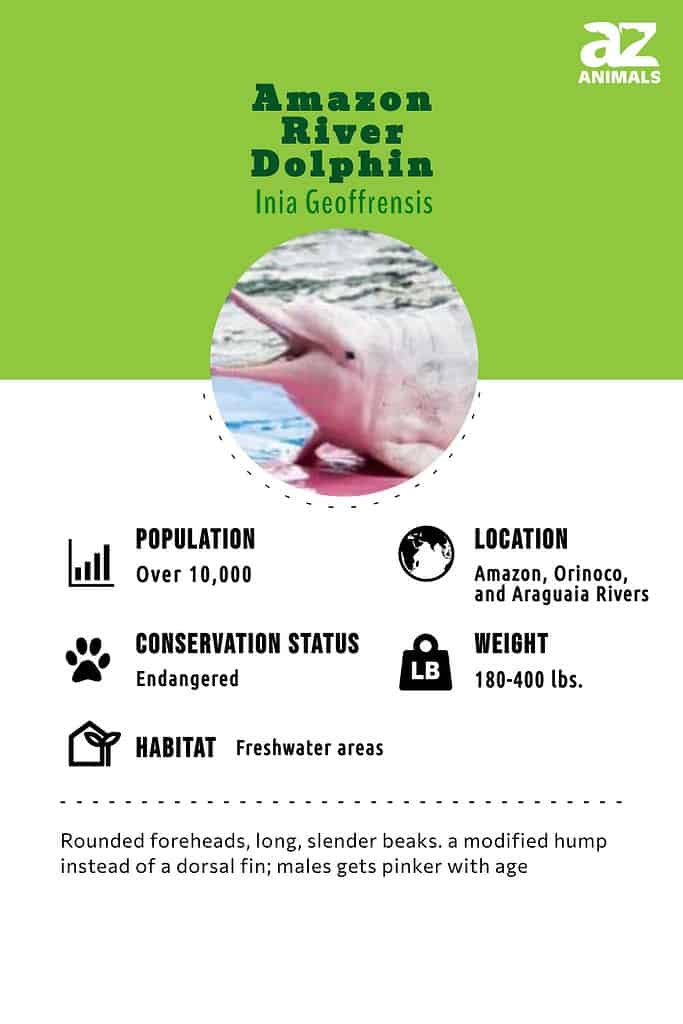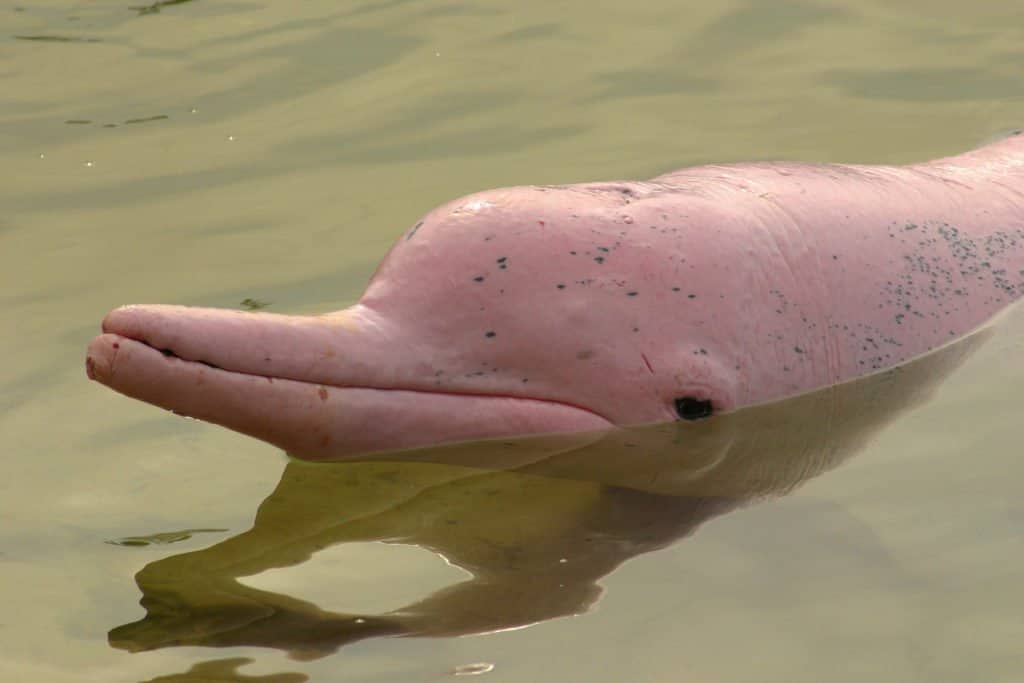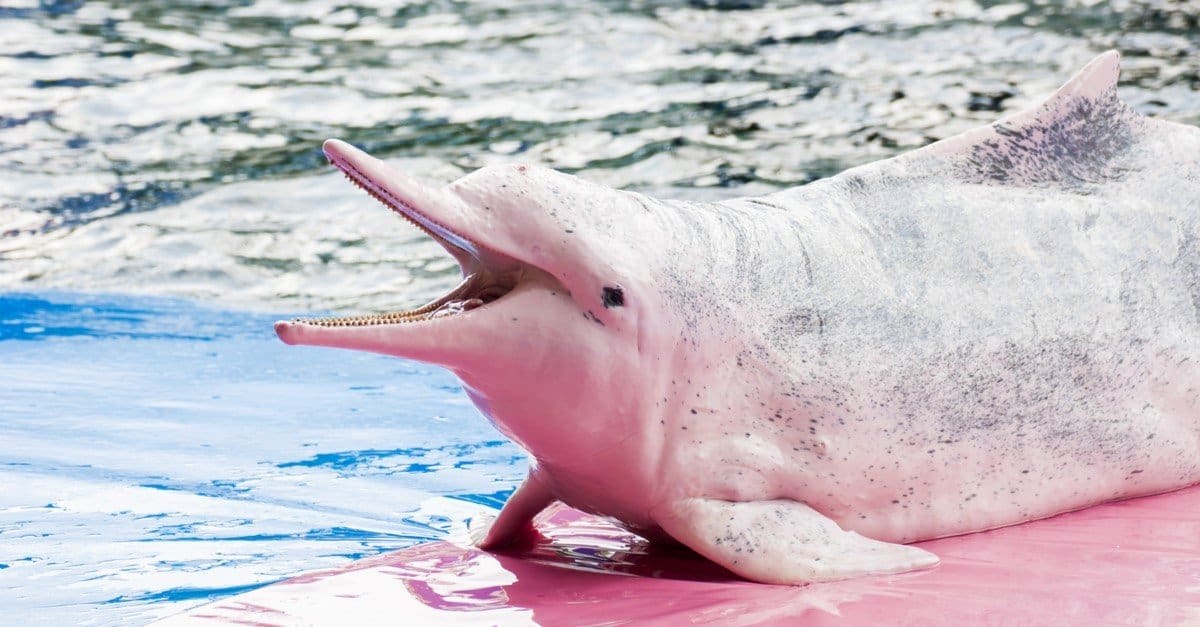Amazon River Dolphin (Pink Dolphin)
Platanistoidea
Also known as the 'Pink Dolphin'
Advertisement
Amazon River Dolphin (Pink Dolphin) Scientific Classification
- Kingdom
- Animalia
- Phylum
- Chordata
- Class
- Mammalia
- Order
- Cetacea
- Family
- Platanistoidea
- Genus
- Platanistidae
- Scientific Name
- Platanistoidea
Read our Complete Guide to Classification of Animals.
Amazon River Dolphin (Pink Dolphin) Conservation Status
Amazon River Dolphin (Pink Dolphin) Facts
- Main Prey
- Fish, Prawns, Frogs
- Habitat
- Large tropical rivers and estuaries
- Predators
- Human
- Diet
- Carnivore
- Average Litter Size
- 1
View all of the Amazon River Dolphin (Pink Dolphin) images!
The Amazon pink river dolphin is the biggest and smartest animal of the freshwater dolphin species.

The Amazon river dolphin (also known as the pink dolphin and botos) is a freshwater animal and a species of toothed whale. It lives in the Amazon, Orinoco and Araguaian river rivers located in Bolivia, Columbia, Ecuador, Brazil, Venezuela, and Peru. The river dolphin is smaller than saltwater dolphins, and the species has excellent hearing. Pink dolphins must live in warm, shallow water areas because they have very little blubber. River dolphins suffer in captivity with few aquariums able to keep them alive.
5 Incredible Facts
• Also known as the pink dolphin: There are many competing theories on why the Amazon river dolphin tends to become more pink as it ages. Read about it below!
• The largest species of river dolphin: River dolphins also live in China and across the Indian subcontinent, but the Amazon river dolphin is the largest species. Males are 50% larger than females and can weigh more than 450 pounds.
• Not one, but three species?: Scientists are currently divided on whether the Amazon river dolphin is actually one, two, or three different species. To see more about this ongoing debate, read our ‘species’ section below!
• Different bodies than ocean dolphins: Unlike ocean dwelling dolphins, pink dolphins have a hump instead of a dorsal fin.
• Upside-down swimmers: Amazon river dolphins will frequently swim upside down. It’s believed the humps on their back rub across the river’s floor and help them locate prey.
Scientific Name and History
The Amazon river dolphin is also called a boto or the pink dolphin, and its scientific name is Inia Geoffrensis.
The animal’s common name comes from where it often makes its home and its skin color. The name boto is the one used by the natives. It is also a popular character in South American mythology. In legends, pink dolphins have amazing musical skills and are seductive. They also love parties. Some myths claim that the dolphins can shapeshift into human form and have magical abilities.

©COULANGES/Shutterstock.com
Freshwater dolphins belong to the Mammalia class. There are five extant species besides the Amazon river dolphin: Tucuxi river dolphin, Ganges river dolphin, Irrawaddy river dolphin, Indus river dolphin, and the Yangtze Finless Porpoise.
It is unknown how or when the dophin got into the Amazon basin, but it may have done so during the Miocene period, entering from either the Atlantic or Pacific Ocean before the formation of the Andes.
Species
There is considerable debate within the scientific community as to whether the Amazon river dolphin is actually one, two, or potentially even three different species.
In 2014, scientists in Brazil published research in the journal Plot One sayiing that river dolphins in the Araguaia river were a unique species: the Araguaian river dolphin (I. araguaiaensis). Also, there has been considerable debate as to whether river dolphins living in Bolivia are a unique species.
As of 2020, the IUCN recognizes three subspecies: the Amazon river dolphin (I. g. geoffrensis), the Bolivian river dolphin (I. g. boliviensis), and the Orinoco river dolphin (I. g. humboldtiana).
Appearance and Behavior
The pink river dolphin features that distinctive dolphin smile. They have rounded foreheads and long, slender beaks.

Pink dolphin in the water
©Anirut Krisanakul/Shutterstock.com
While other river dolphin species — such as the Ganges river dolphin — have dimorphism where females are larger than males, the opposite is true in Amazon river dolphins. Males can grow to be about 50% larger than females and weigh in excess of 400 pounds (180 kg).
The animal has conical-shaped teeth that they use to catch small fish and other prey. The river dolphin features a long nose that can measure up to 23 inches long, and this is about four times longer than the nose of ocean dolphins. The river dolphin has a two-chambered stomach, and they breath by emitting air through a blowhole.
Pink dolphins swim with great precision. Because river dolphins are extremely flexible, they can maneuver around rocks, tree trunks and other objects. They also have the ability to swim forward using one flipper while the other flipper paddles backward. This swimming method lets them make tight turns. River dolphins also like to swim upside down.

Pink dolphins swim in groups and are friendly and curious, interacting with humans frequently.
©iStock.com/Michel VIARD
River dolphins have exceptionally large brains, and while dolphins are known for swimming in groups, river dolphins tend to spend more time alone or among small groups of two to four dolphins. You might see a bigger group of them in areas that are rich with food, but it’s less common with river dolphins.
The Amazon river dolphin doesn’t have a dorsal fin. Instead, it sports a modified hump. The animal makes its way through rivers and flooded areas using strong flippers and a tail fluke. Compared to oceanic dolphins, pink dolphins swim slowly. Their top speed is around 35 miles per hour. The reason for this is that their neck vertebrae are not fused. This gives them more flexibility, but it means that they can’t swim as fast. River dolphins are able to turn their heads without shifting their bodies.
River dolphins have unique ear adaptions to help them survive in their watery environment. Dolphins hear sound from their throats instead of from their outer ear to their inner ear. The animal’s ear is also acoustically separated from its head. Separating these two body parts are sinus pockets. The combination gives the animal enhanced directional hearing under the water. Dolphins use an organ called a melon to emit high frequency clicks. This allows them to produce bio sonar. They use it to orient themselves.
Dolphins are reliant on echolocation. The animal species uses echolocation so well that a river dolphin could survive even if it were blind. Echolocation lets the animal determine the size and shape of any surrounding item or object. River dolphins have small eyes, and they are unable to see well. Also, their eyes are on the sides of their heads. This means that their vision features two separate views instead of the forward view that people see.
Researchers believe that some types of pink dolphins are blind while others just have extremely poor eyesight. These dolphins, like their saltwater cousins, are friendly and curious about humans. That can be a problem, considering their eyesight: a number of the animals are killed because they inadvertently come into contact with nets and fishing boats.
Pink Dolphin: Why Amazon River Dolphins Are Also Known as “Pink Dolphins“
One of the defining features of Amazon river dolphins is they often turn pink. Scientists are still researching the reasons for this unique coloration, but a few theories stand out.

The pink coloration of the Amazon river dolphin may be due to scar tissue or camouflage.
©Ivan Sgualdini/Shutterstock.com
- Fighting: While not aggressive with humans, Amazon pink river dolphins will often fight one another and leave significant amounts of scar tissue. It’s hypothesized this scar tissue turns pink, and is a reason why older males tend to have the most distinctive pink coloration.
- Camouflage: Amazon pink river dolphins live in rivers along the Amazon rain forrest which are often inundated with incredible amounts of rain. This high level of rainfall causes the muddy bottoms of rivers to turn a red/pink hue. Amazon pink river dolphins may have simply evolved to better blend in with their surroundings.
It’s important to note that most Amazon river dolphins are born with gray tones, and males tend to become more pink as they age. In addition, this pink coloration normally covers parts of their body while areas of grey remain. It’s hypothesized that males with more pink coloration are better able to attract mates.
Habitat
Amazon pink river dolphins live in freshwater areas including lakes, enormous rivers and small tributaries. As the Amazon is fed by large stretches of rain forrest, every year it floods its banks for extended periods of time. During this period, Amazon pink river dolphins will expand across the vast inland seas that are created in floodplains.
You’ll find them in Bolivia, Columbia, Ecuador, Brazil, Venezuela and Peru. The Amazon pink river dolphin also lives in the Amazon and Orinoco riverways and in the Araguaia River.
Diet
Amazon river dolphins have teeth that are similar to the molar teeth that humans have. Like people, the animals use their teeth to break up food before swallowing it. River dolphins aren’t picky about what they eat. The mammals will dine on turtles, shrimp, crabs and more than 40 different species of fish including piranhas.
Predators and Threats
Animals that prey on the river dolphin include large snakes, jaguars and caimans. However, once the species has passed adolescence they have few natural predators.
Human development and farming have had a major impact on the habitats of the river dolphin. These activities have impacted the ecology of the waterways. Human fishing is also threatening the species. Overfishing is a problem because it decreases the animal’s food supply. The dolphins also get caught in the nets.

Indo-Pacific humpback dolphin (Sousa chinensis).
©wasanajai/Shutterstock.com
Pollution is another threat to the Amazon river dolphin. Small gold mining operations cause mercury pollution, and this makes its way to dolphins through the food chain. River dolphins eat a lot of catfish, which dwell on the bottom of waterways where mercury generally accumulates.
Amazon river dolphins are endangered. The Brazilian Institute of Environment and Renewable Natural Resources has taken steps to protect the dolphin species. They’ve made it illegal for fishermen to kill the dolphins.
Reproduction, Babies and Lifespan
In South America, spring is the rainy season. During this time, acres and acres of rainforest floods, turning into an enormous tree-covered sea. The water becomes deep enough for the river dolphins to swim amongst the trees. Mating season occurs when the water recedes, and the male and female dolphins are constricted to the river channels. The dolphin species is polygamous, meaning males mate with several females each year. However, females don’t mate every year. They mate every two to three years.
Female river dolphins are more attracted to males that are a brighter shade of pink. To impress the females, male river dolphins smack the water with bunches of grasses or branches in their mouths. Sometimes, they hold up a turtle to capture the attention of a female. When a female river dolphin becomes pregnant, she’ll carry the calf for 11 to 15 months. The animal species gives birth to just one calf. After a baby dolphin is born, it will nurse for over a year. Baby dolphins are often around 30 inches long, and they weigh around 22 pounds. Adult female dolphins usually have their calves from July to September. Once they’re born, babies remain close to their mothers for protection.
Sexual maturity is based on the dolphin’s size. When a female reaches 5.5 feet in length, she becomes sexually mature. Males reach the stage once they’re 7 feet long. In the wild, river dolphins live for an average of 12 to 18 years, but they can live for as long as 30 years.
Population
The Amazon river dolphin population is difficult to estimate because the dolphins live in remote, muddy waters and lack a distinctive dorsal fin that makes spotting them easier. Nonetheless, the population is thought to be over 10,000.
However, river dolphins are under threat. For instance, the Araguaian river dolphin population is from 600 to 1,500 animals.
Amazon River Dolphin (Pink Dolphin) FAQs (Frequently Asked Questions)
Are River Dolphins Carnivores, Herbivores or Omnivores?
Amazon river dolphins are carnivores. They only eat meat.
Are River Dolphins Dangerous to Humans
Most of the time, dolphins are not dangerous to humans. In fact, the animals are super curious, friendly and generally approachable. They often have fun with humans by teasing them and seeking their attention. There are even accounts of the species protecting people from sharks or helping a lost person make his or her way back to land.
The only time that dolphins are likely to harm humans is if they are agitated or provoked. If you come across a river dolphin and want to feed him or her, keep in mind that it might be prohibited.
How Do Dolphins Sleep?
Most dolphin species sleep by resting one hemisphere of their brain in what’s called slow-wave sleep. During this state, they stay alert enough to keep breathing and look out for predators. The Indus river dolphin sleeps differently. Since the animal lives in waters with powerful currents and a great deal of floating debris, the dolphin must stay alert to avoid becoming injured. To stay safe, the dolphin sleeps in short four to 60 second spurts.
Are Amazon River Dolphins actually pink?
Some are. Amazon river dolphins are born grey and turn varying degrees of pink throughout their life. Males tend to become especially pink as they age. It’s believed this pink coloration is the result of their aggressive behavior, with teeth marks from other males leading to pink scar tissue that eventually covers the majority of their body.
What Kingdom do Amazon River Dolphin (Pink Dolphins) belong to?
Amazon River Dolphin (Pink Dolphins) belong to the Kingdom Animalia.
What phylum do Amazon River Dolphins (Pink Dolphins) belong to?
Amazon River Dolphins (Pink Dolphins) belong to the phylum Chordata.
What class do Amazon River Dolphins (Pink Dolphins) belong to?
Amazon River Dolphins (Pink Dolphins) belong to the class Mammalia.
What family do Amazon River Dolphins (Pink Dolphins) belong to?
Amazon River Dolphins (Pink Dolphins) belong to the family Platanistoidea.
What order do Amazon River Dolphins (Pink Dolphins) belong to?
Amazon River Dolphins (Pink Dolphins) belong to the order Cetacea.
What genus do Amazon River Dolphins (Pink Dolphins) belong to?
Amazon River Dolphins (Pink Dolphins) belong to the genus Platanistidae.
What type of covering do Amazon River Dolphins (Pink Dolphins) have?
Amazon River Dolphins (Pink Dolphins) are covered in Smooth skin.
In what type of habitat do Amazon River Dolphins (Pink Dolphins) live?
Amazon River Dolphins (Pink Dolphins) live in large tropical rivers and estuaries.
What is the main prey for Amazon River Dolphins (Pink Dolphins)?
Amazon River Dolphins (Pink Dolphins) prey on fish, prawns, and frogs.
What are some predators of Amazon River Dolphins (Pink Dolphins)?
Predators of Amazon River Dolphins (Pink Dolphins) include humans.
What is the average litter size for an Amazon River Dolphin (Pink Dolphin)?
The average litter size for an Amazon River Dolphin (Pink Dolphin) is 1.
What is an interesting fact about Amazon River Dolphins?
Amazon River Dolphins are also known as the “Pink Dolphin.”
What is the scientific name for the Amazon River Dolphin (Pink Dolphin)?
The scientific name for the Amazon River Dolphin (Pink Dolphin) is Platanistoidea.
What is the lifespan of a Amazon River Dolphin (Pink Dolphin)?
Amazon River Dolphins (Pink Dolphins) can live for 12 to 18 years.
How fast is an Amazon River Dolphin (Pink Dolphin)?
An Amazon River Dolphin (Pink Dolphin) can travel at speeds of up to 18 miles per hour.
Thank you for reading! Have some feedback for us? Contact the AZ Animals editorial team.
Sources
- David Burnie, Dorling Kindersley (2011) Animal, The Definitive Visual Guide To The World's Wildlife
- Tom Jackson, Lorenz Books (2007) The World Encyclopedia Of Animals
- David Burnie, Kingfisher (2011) The Kingfisher Animal Encyclopedia
- Richard Mackay, University of California Press (2009) The Atlas Of Endangered Species
- David Burnie, Dorling Kindersley (2008) Illustrated Encyclopedia Of Animals
- Dorling Kindersley (2006) Dorling Kindersley Encyclopedia Of Animals
- David W. Macdonald, Oxford University Press (2010) The Encyclopedia Of Mammals

















